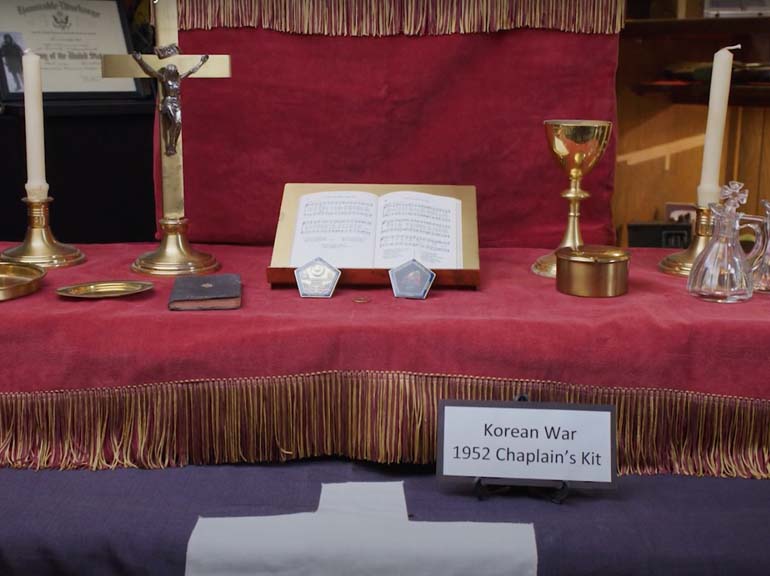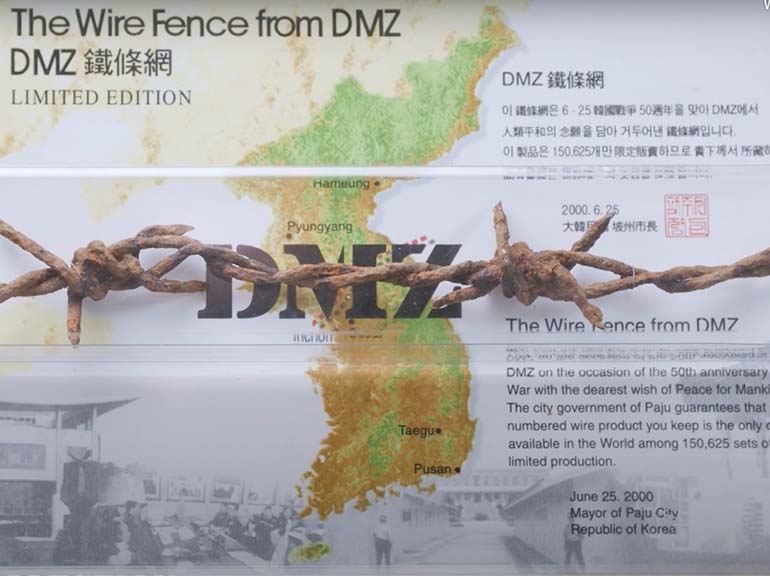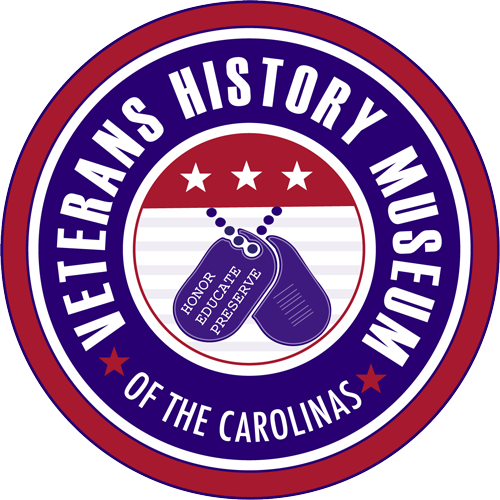Korean Exhibit
Actual weapons and artifacts form the Korean War and the Cold War eras are on display in this exhibit. Several uniforms and flight suits from local veterans are highlighted. Rare vintage weapons and equipment are also on display.

Chaplin Kit used in Korean War

Infrared Sniper Scope

Barbed Wire from DMZ
Korrean War
“The long nights. Too long. Time stops, frozen in place. I beg the frozen hours for the sunrise.
Too many memories. Ice and death. I’m ready to join my friends.”
A U.S. Marine at the Chosin Reservoir. From The Frozen Hours, by Jeff Shaara.
Cold War begins in 1947
The rise of global communism and territorial divisions following WWII resulted in a Cold War beginning in 1947. The war turned hot in 1950, when the North Korean People’s Army, supported by the Soviet Union and the People’s Republic of China, invaded South Korea. The United Nations responded to the communist aggression with military force led by the US.
After a string of victories by the North Korean army, the tide turned with a surprise amphibious assault commanded by General Douglas MacArthur at the South Korean city of Inchon. UN forces recaptured the besieged South Korean capital of Seoul.
Enemy forces travelled at night, moving into position for an attack. In defense, the United States used a Sniper scope to locate enemy filtration. These infrared devices had tremendous value along perimeter defenses and listening posts.
MacArthur then commanded UN troops in an invasion of North Korea
Desiring to squash the Communist forces, MacArthur then commanded UN troops in an invasion of North Korea. China threatened to retaliate if UN forces approached the border on the Yalu River. Believing it was an idle threat, MacArthur continued to move his forces north.
Brutal weather conditions
Although some troops were appropriately attired for the increasingly cold climate, many had been deployed quickly and travelled without uniforms suitable for a North Korean winter.
Stealthily at night, several hundred thousand Chinese troops entered Korea, as the unknowing Allies moved ever-northward. In November 1950, Allied forces, were caught completely off guard as the Chinese surrounded them at the Chosin Reservoir. On the brink of annihilation, Marines and soldiers fought for their lives against the most brutal weather conditions imaginable—and an enemy which outnumbered them more than four to one.
Enduring the misery of temperatures ranging from 20-to-42 degrees below zero, hoods pulled tight against the wind, the men chipped shallow trenches in the ice. Socks, wet from the sweat of the day’s endeavors, froze at night. Frostbite resulted in hundreds of amputations. Rifles, Jeep batteries, plasma, and medical supplies froze. Rations and the water in canteens turned to ice. Men began to starve.
The enemy came at night. Accompanied by bugles and cymbals, wave after wave of Chinese attacked the lines. Each wave, mowed down, was quickly replaced by another. The enemy came from every direction and fought until dawn. Frozen, snow-covered bodies were used as sandbags. One small saving grace: blood froze, preventing wounds from bleeding out until the injured warrior arrived at a medical tent.
Chosin Reservoir in one of history’s most harrowing battles
Cut off from reinforcements and with dwindling supplies and ammunition, the Marines, soldiers, and UN forces fought their way out of the Chosin Reservoir in one of history’s most harrowing battles. The courage of these men in the face of almost suicidal odds served as a lasting tribute to their dogged determination and fighting skill.
Fighting in North and South Korea continued through the first six months of 1951. Seoul changed hands again twice, finally liberated by UN forces. The city was devastated by fighting and its population was reduced to a fraction of its prewar size.
Among the unsung heroes of the Korean War were the members of the U.S. Army Chaplain Corps. Chaplain kits were issued in hard metal cases with a cover to form an altar. These kits included variations for Protestant, Catholic and Jewish chaplains.
The story of the Korean War is filled with countless tales of individual courage in the face of the enemy. Charles George, a 20-year-old U.S. Army soldier and Cherokee Indian, threw himself on a grenade to protect other soldiers in his company. Although fatally wounded, he refrained from any outcry which would divulge the position of his companions. He was awarded the Medal of Honor posthumously in 1954. The VA Medical Center in Asheville is named in honor of Charles George.
July 1953, an armistice ended three years of fighting
In July 1953, an armistice ended three years of fighting with millions of casualties and virtually no change in the border. The Korean Peninsula is still divided, with military personnel from both North and South Korea occupying the demilitarized zone. Stretching across the peninsula, the two-mile-wide swath of land is bounded on both sides by several lines of barbed wire fence and one of the largest concentration of soldiers and artillery in the world.
After experiencing war through these videos, we feel grief, respect, admiration, and gratefulness for those who gave all, for those who came through so changed (or damaged), and for those who loved and love them. The best we can do is to listen to their stories. To try to see through their eyes and understand what they sacrificed. This is how we honor their courage and love of our country.
